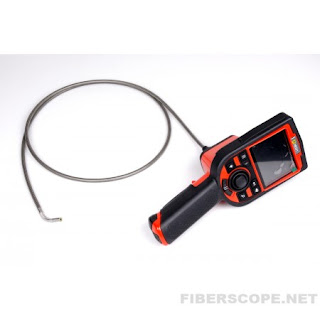Some specialists are
interested in rigid borescopes and they want to know their pros and cons.
A rigid optical borescope (can be seen here) is an optical device with a rigid metal tube and eyepiece on one end
and an objective lens on the other. Between them we can find a complex relay
optical system. Optical systems in them can be of three main types: Hopkins rod lenses, achromatic doublets
and gradient rod lenses. For large diameter the achromatic doublet relays are
good, but as the diameter tube gets smaller the rod lenses provide better images. For very small rigid borescopes, the gradient index
lens relays are better. The tube contains also glass fibers for illumination.
The
illumination can be provided either by LED light source attached as a handle to
the light post of the borescope, or by external powerful Metal Halide, Xenon or
Halogen light source. In this case the light is transferred via flexible glass
fiber guide. alideAn internal
image of the object is formed by the objective lens and magnified by the
eyepiece, which presents it to the eye.
What are advantages
of rigid borescopes? They provide a superior image at a lower cost
compared to a flexible fiberscopes. The
image is exceptionally clear. When an object is located within direct access,
rigid borescopes work well. They are recommended for gunsmithing, automobile
inspection like observation of automotive cylinders, injectors and hydraulic bodies.
It is possible to attach a video camera to the eyepiece, and after that the
inspector can record video and still images for further processing.
What then are
disadvantages of rigid borescopes? Rigid borescopes are limited to access to a
straight line. It is impossible to view hidden objects behind something. Besides they are fragile instruments and don’t
like falling down.
There are many rigid borescopes in the market
with diameter from 1.8 mm to 8 mm and length from 10 cm to 90 cm. As you can see they have more advantages than
disadvantages and can be very efficient for inspection work
 There are many industrial areas which require careful inspection. Gas Safety Regulations demand regular inspection of gas cylinders for defects. Many techniques are used to achieve this. Often visual inspection by borescope or video borescope is applied. The insertion probe of videoscope is inserted into empty cylinder and the operator can observe the inner surface.
There are many industrial areas which require careful inspection. Gas Safety Regulations demand regular inspection of gas cylinders for defects. Many techniques are used to achieve this. Often visual inspection by borescope or video borescope is applied. The insertion probe of videoscope is inserted into empty cylinder and the operator can observe the inner surface. 
